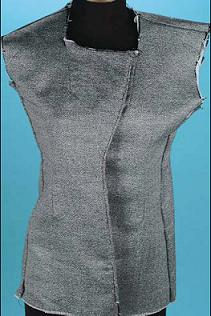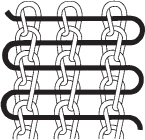
Interfacing and Stabilizer
Easy
For every fabric, you have a choice of several interfacings. Your selection will be determined by availability; the fabric care; amount and direction of stretch; quality, weight, hand, and color; the fiber content; garment quality, type, design, use, and desired finished appearance; your sewing skills, time available, and personal preference. It is not uncommon to use several different interfacings in a single garment.
The most common interfacings are listed in the Interfacing Checklist (Appendix G). The chart is divided into two sections: fusible and sew in; then the interfacings are listed by weight. Similar products are grouped together so you can make substitutions when necessary.
For most fabrics, you can use several different interfacings; and even though the results may be different, there is rarely a wrong choice. Recently I made two jackets—same pattern, same fabric. On one, I used only fusibles; on the other, traditional hair canvas. Both look great. The fused jacket has a crisper, slick look while the hair canvas design is a little softer with a more supple, tactile quality.
Application
sew in interfacings are sewn into the garment by hand or machine. Available in most fibers, they can be woven, nonwoven, or knit.
Fusible interfacings have a resin on one side and are bonded to the fabric when heat, moisture, and pressure are applied. They can be woven, nonwoven, tricot, warp-insertion or weft insertion knits. All fusibles will make fabrics crisper after fusing and less tactile. Fusibles cannot be used on some fabrics because fusing will damage them or they will not adhere well.
Fabric Structure
Woven interfacings have stability in the lengthwise grain and slight give in the crossgrain. sew in or fusible, they are suitable for all woven fabrics. They can be machine washed and dried or Drycleaned.
Hair canvas is a woven interfacing for tailoring. Woven with wool, goat’s hair, and other fibers, the quality improves with the amount of wool and hair. It requires Drycleaning.
Nonwoven interfacings are felt-like materials which do not ravel. Well suited for washable garments and knits, nonwovens can be machine washed and dried or Drycleaned.
Stable nonwoven interfacings have no grain and no give. They are firm and can be cut in any direction.
Stretch nonwoven interfacings have crosswise stretch. They are suitable for knits, bias cut fabrics, and stretch wovens.
All-bias nonwoven interfacings have some give in all directions. They are suitable for supple, unstructured shapes.
Tricot interfacings have crosswise stretch and can be used to interface or underline knit and woven fabrics.


This sample jacket utilizes a combination of sew ins and fusibles on the front and the back. (Photo by Robert Best.)

Tricot
Easy
Stabilized tricot is a sew in knit which is stable in the length and width, with stretch on the bias. It does not fray or run when edges are left raw.

Stabilized tricot
Warp-insertion interfacings are fusible knit interfacings with yarns inserted lengthwise. This structure produces stability in the length and stretch in the width.

Warp insertion
weft insertion interfacings are fusible knit interfacings with yarns inserted horizontally. This structure produces stability in the crossgrain and stretch and recovery in the length. Well suited for tailoring, weft insertions are more supple than woven fusibles and more stable than knits.

Weft insertion
Fusible woven interfacings describe themselves.The limited selection in the interfacing department can be expanded by applying a fusible web to a sew in interfacing with a fusible web on release paper or a Teflon release sheet.
Fusible web is a mesh of polyamides which melt. With heat, moisture, and pressure, fusible webs can join two fabric layers permanently for hemming, appliqués, or interfacing. They can be applied to a single layer of fabric with a Teflon release sheet. Some fusible webs are packaged on paper release sheets.
Release sheets are Teflon-type sheets which allow you to bond a fusible web to a fabric without gumming up the iron.
Fusing Interfacings
Heat and moisture melt the resin, and pressure pushes it into the fibers.
1. Read the instructions with the interfacing.
2. Cover the pressing surface with paper towels. Place the fabric, wrong-side up, on the paper towels.
3. Place the interfacing, resin side down, on the fabric.
Hint: When fusing to a portion of a section, trim the edge with pinking shears to avoid a demarcation line.
4. Cover with a press cloth, dry or wet depending on the instructions.
5. Baste press lightly in several areas if the section is large.
Note: When working with loosely woven fabrics, the garment section is frequently larger than the interfacing, even though they were cut by the same pattern. Do not force the edges to match; the fashion fabric has stretched out of shape. If you have cut accurately, use the interfacing as a guide.
6. Set the iron on “wool.”
7. Beginning in the center of the section, fuse toward the edges. Press hard with steam, unless the instructions indicate otherwise, for 10 to 15 seconds. Overlap the fused areas carefully to avoid a bare section. Do not slide the iron.
8. Turn the section over; cover with a press cloth; and fuse the other side.
9. Allow the section to cool before moving it.
10. Test to be sure all corners are securely fused.
Stabilizers
Stabilizers support the fabric during construction for tissue stitching, appliqué, seaming, buttonholes, embroidery. They tear away or dissolve with water, steam, or heat after stitching. (See Appendix E – Stabilizers.)
Claire’s Hints
1. Interfacings should have the same care requirements as the garment.
2. Preshrink all interfacings before using. Place in a sink with very hot water; leave about 30 minutes; then hang to dry. Do not shrink fusibles in a washer or dry in dryer.
3. Always test fuse when using fusibles. This is particularly important when fusing to a portion of a section because the fusible may change the hand or drape or make a demarcation line at the edge.
4. Keep a record of the products you use with notes about the results.